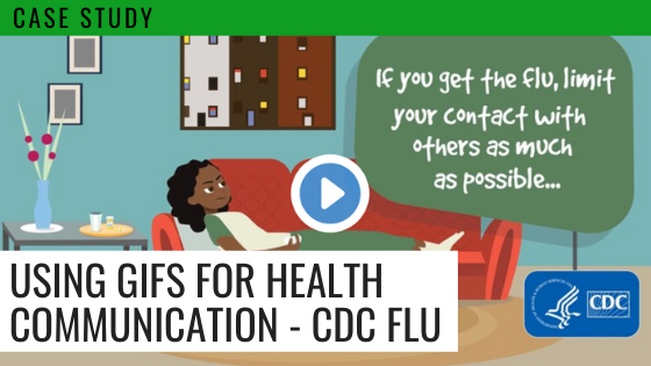Why use animated GIFs?
Animated GIFs can be far more engaging than static images. CoSchedule reports that tweets with GIFs get 167% more click-throughs than tweets with static images, and according to Insight Pool, sharing a post with a GIF increased the engagement rate 20% for B2C brands. Social Media Today says tweets with GIFs generate 6X more engagement than tweets with basic text updates, and are 3X as likely to be retweeted than tweets with images.
GIFs can backfire, though. The folks at Hootsuite advise against posting GIFs that are out of context, too casual, or overly branded. They also recommend using GIFs to advertise sales and events, feature products, visualize data, and share instructional content. You can check out Hootsuite's Ultimate GIF Guide for Social Media Marketers for more insights and tips.
Are you thinking about creating animated GIFs for health communication?
Take a look at these animated GIFs from the #FluTip series posted by @CDCFlu on Twitter.
Handwashing GIF
This GIF earned @CDCFlu 180 retweets, 132 likes, and 2 comments.
Stay Home GIF
This GIF earned @CDCFlu 612 retweets, 470 likes, and 20 comments.
Antiviral Treatment GIF
This GIF earned @CDCFlu 73 retweets, 65 likes, and 3 comments.
The antiviral treatment GIF had the lowest total engagement. It must be noted that we are comparing apples and oranges, in the sense that we don't know how many people viewed each post (reach) or how many times each post was viewed (impressions). Without those denominators, we can't definitively say which post performed best. The stark difference in the total engagement between the posts that modeled a behavior and the one post that did not, however, does raise some questions. Is the animation in behavior change and social marketing GIFs better when used for demonstrating a behavior? Is animation distracting when it involves only text elements and does not model a behavior/action?
Share your thoughts with us in the comments.
0 Comments
Your comment will be posted after it is approved.
Leave a Reply. |
�
Learn about our blog submission guidelines. >>
The views and opinions expressed by individual authors on this blog are their own and do not necessarily reflect the official policy or position of Let's Talk Public Health.
Categories
All
|
|
Highlights
Explore
Connect
|


 RSS Feed
RSS Feed